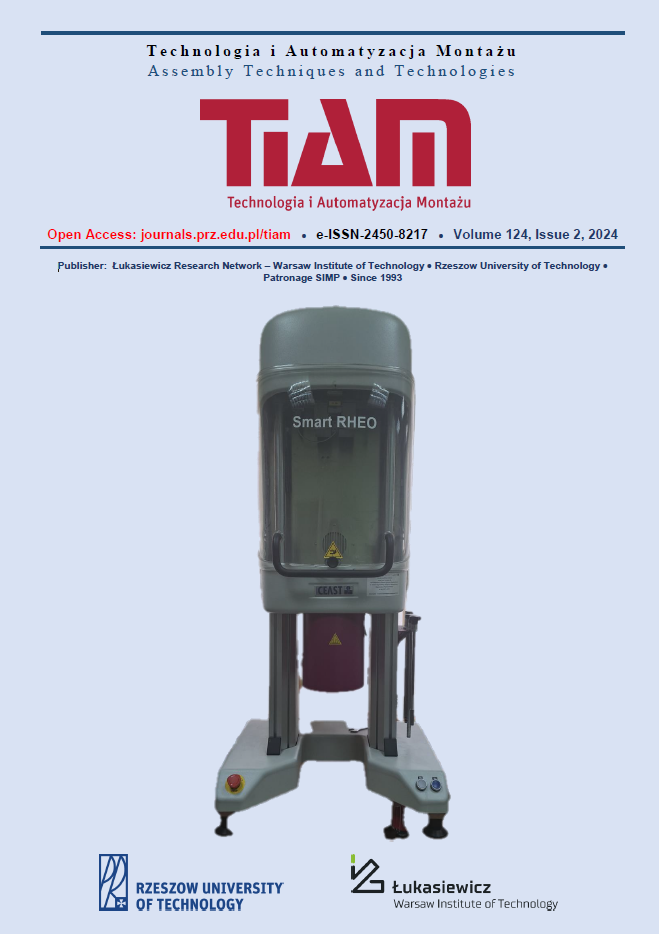Abstract
This paper presents the concept of an automotive battery assembly line. The line includes in its structure fully and semi-automated assembly sockets, as well as manual assembly sockets. The transport between the sockets is carried out using an AGV autonomous trolley system. The selection of the assembly process execution method was based on an analysis of the technical feasibility of the process as well as an analysis of the occupation time of individual assembly stations. The resulting line structure indicates to what extent the automation of the assembly process contributes to a change in material flow and influences the way the process is carried out, including a variety of technical means used. The paper presents an analysis of the use of particular workstations. This analysis was used to optimise the flow of the component assembly line. Maximum utilisation of the resources involved in the production process was used as a criterion for optimisation.
References
Autocar. (2024, 04 04). Pobrano z lokalizacji https://www.autocar.co.uk/car-news/advice-electric-cars/how-long-do-batteries-last-electric-cars
Brzozowska, J., & Gola, A. (2021). Computer aided assembly planning using MS Excel software – a case study. Applied Computer Science(17(2)), pp. 70-89. doi:https://doi.org/10.35784/acs-2021-14
Domińczuk, J. i Gałat, M. (2023). Automated system of inter-operational transport with a pneumatic drive. Assembly Techniques and Technologies, strony 13-19. doi:https://doi.org/10.7862/tiam.2023.4.2
E-mobility engineering. (2024, 04 04). Pobrano z lokalizacji https://www.emobility-engineering.com/automated-battery-manufacturing/
Gola, A. (2021). Biblioteka Cyfrowa Politechniki Lubelskiej. Pobrano z lokalizacji https://bc.pollub.pl/dlibra/publication/14005/edition/13663
Kaczmarek, W. i Panasiuk, J. (2018). Robotyzacja procesów produkcyjnych. Warszawa: PWN.
Koch, T. (2006). Systemy zrobotyzowanego montażu. Wrocław: Oficyna Wydawnicza Politechniki Wrocławskiej.
Kolberg, D., & Zuhlke, D. (2015). Lean Automation enabled by Industry 4.0 Technologies. IFAC-PapersOnLine(3), pp. 1870-1875. doi:https://doi.org/10.1016/j.ifacol.2015.06.359
Łapczyńska, D. (2023). The possibilities of improving the human-machine co-operation in semi-automatic production process. Assembly Techniques and Technologies, strony 30-36. doi:https://doi.org/10.7862/tiam.2023.1.4
Pressreleasefinder. (2024, 04 04). Pobrano z lokalizacji https://www.pressreleasefinder.com/SABIC/SABICPR555/en/
Rudawska, A., Domińczuk, J., Miturska-Barańska, I., Doluk, E., Szabelski, J. i Gola, A. (2023). Podstawy technologii montrażu. Wydawnictwo Politechniki Lubelskiej.
Stadnicka, D. (Red.). (2021). Lean manufacturing. Rzeszów: Oficyna Wydawnicza Politechniki Rzeszowskiej.
Stadnicka, D. (Red.). (2021). Problemy w obszarach produkcyjnych. Rzeszów: Oficyna Wydawnicza Politechnuiki Rzeszowskiej.
Stadnicka, D., Sęp, J., Amadio, R., Mazzei, D., Tyrovolas, M., Stylios, C., . . . Navarro, J. (2022). Industrial Needs in the Fields of Artificial Intelligence, Internet of Things and Edge Computing. Sensors. doi:https://doi.org/10.3390/s22134501
Więcek-Janka, E., Pawlicki, J. i Walkowski, P. (2018). Przykład wprowadzania usprawnień w procesach produkcyjnych. Zeszyty Naukowe Politechniki Poznańskiej, 271-282. doi:10.21008/j.0239-9415.2018.076.20

